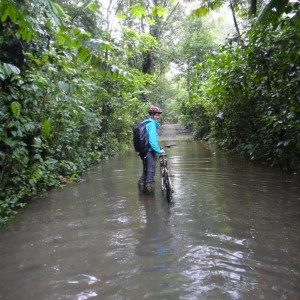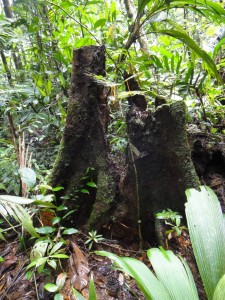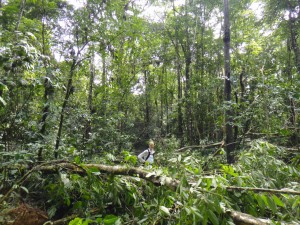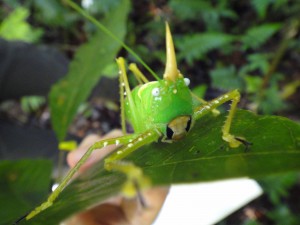Over the course of the semester, PCURs will explain how they found their place in research. We present these to you as a series called The Project That Made Me a Researcher. As any undergraduate knows, the transition from ‘doing a research project’ to thinking of yourself as a researcher is an exciting and highly individualized phenomenon. Here, Zoe shares her story.
~~~~~~

It was my first full day in Costa Rica. The dawn chorus of howler monkeys and quavering calls of Great Tinamou awakened us to a morning of intermittent showers, but no thunder — a good start, by rainforest standards.
Shouldering our backpacks, Cleo (my summer mentor) and I headed to the field, biking along the forest trail until a fallen tree forced us to leave our bikes and walk to the mud-slick path where some of Cleo’s study saplings grew. She had been tracking these trees for a year and half as part of her Ph. D.
Everything that morning felt strange and new: my heavy snakeproof boots, the dripping forest canopy, the squish of mud and fallen leaves beneath my feet. This was not my first time in a forest, nor my first time doing research. But it was my first time doing research like this – research that I lived from dawn until I fell asleep.

I was running a project alongside Cleo’s, measuring variation in the saplings’ leaves by collecting leaf samples with a heavy-duty single-hole puncher: four punches per leaf and four leaves per tree, for each of the 224 study trees.
That first morning, we worked through intermittent rain. The hole puncher was stellar, but the tiny circles of leaf were about as cooperative as the weather, slipping between our wet fingers and flying onto the forest floor. (“Try and sample me now!” I imagined them hollering.) After a few hours, we had sampled just six trees. We decided to stop for lunch.
“It seems darker,” Cleo said, looking up at the sky. “Was it this dark in the forest?”
“No, I think it got darker,” I agreed.
Right on cue, it started raining again — hard. The howler monkeys, which had been grumbling noisily all morning, gave loud voice to their displeasure.
“Maybe we should go!” Cleo shouted over the now-bucketing rain. We started shoving everything into our packs and scrambled back out the slick, muddy trail. “Watch out for falling trees!” Cleo yelled over her shoulder. “Keep looking up!”
I looked up. Above us, the entire canopy was wobbling in the wind. While no one tree seemed particularly likely to come crashing down, none looked too sturdy. Cleo was already part-powerwalking, part-running away, glancing over her shoulder every few seconds to check the trail behind us. I took off after her, my backpack bobbing, its rain-cover flying, and my five-pound snake-proof boots slapping against my shins.

On our way back to our bikes, we passed two places where huge canopy trees, their branches heavy with rainwater and tossed by the wind, had come crashing down across the path. In the morning, we had marveled at how treefalls create such amazing light opportunities for understory saplings – one of the driving questions of Cleo’s research. Amid the thundering storm, falling trees suddenly seemed less like amazing opportunities, and more like innocent-researcher death traps.
Mounting our bikes, we frantically pedaled on a little farther before reaching yet another fallen tree, wrapped in vines and branches, that completely obscured the path.
“Maybe we should drop the bikes and go!” Cleo yelled over the rain.
“I think we can get them through!” I yelled back. I started crashing over the tree, trying not to think about snakes.
“WILL THE BIKES HELP US GET TO SAFETY FASTER?” Cleo shouted.
Oh no, I thought. This is bad.
“Pass me your bike!” I hollered.
“Pass” is a generous description (“threw”? “wrenched”? “smashed”?), but we managed to get the bikes over the treefall relatively intact. We rode off down the trail again, my rain fly – long since detached from my soaked pack – flapping from my left handlebar.
We finally arrived back at the field station just as the storm was exhausting itself and the rain slowing to sporadic drips from the drenched canopy.
“Field days are not normally like this,” Cleo said as we locked up our bikes outside the office. But by the time our hard-won samples were in the fridge and our soggy boots were off, we were both laughing. Six trees down. Only 218 to go.

The summer didn’t get much drier, at least for a long time – The trail stayed flooded for the next month. But I fell in love with both the rain and the rainforest: the unpredictability of monkey sightings, insect encounters, and thundering storms; the thrill of the teeming, chirping, rain-dripping forest, and of feeling alive within it. And I learned, that summer, the drive of research – the motivation that sent us to the field day after day, to collect one stubborn leaf sample at a time, rain or shine.
–Zoe Sims, Natural Sciences Correspondent

